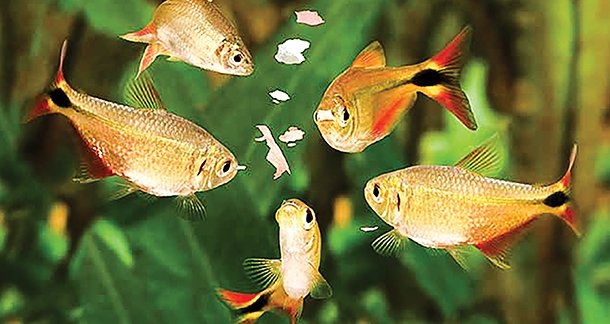By Abhisek Mallic*
The realm of aquarium husbandry has long been anchored to the conventional practice of feeding fish with pellet-based diets. While this method has served its purpose, it also presents a host of challenges that significantly impact both hobbyists and aquatic life.
Catering to the diverse dietary needs of fish within a single aquarium has been a perennial challenge. The varied sizes and specific nutritional requirements of different species necessitate a complex feeding regimen involving multiple pellet sizes. This not only adds to the workload of aquarium owners but also increases the likelihood of uneaten food contaminating the water, leading to potential water quality issues. Moreover, the hardness of traditional pellets can pose digestive problems, particularly for delicate or smaller fish species, compromising their overall health and well-being.

Young fry and juvenile fish have unique nutritional demands, requiring fine powders or micron-sized feeds to support optimal growth and development. On the other hand, adult fish, especially larger species, require larger-sized feed to satiate their appetites. This stark contrast in dietary preferences within the same aquarium environment has been a persistent hurdle for aquarists seeking to provide balanced nutrition to their aquatic companions.
To address these challenges, we have developed a groundbreaking paste feed that represents a paradigm shift in aquarium nutrition. Unlike pellet-based feeds, our paste is designed to be versatile, convenient, and highly digestible. Its unique formulation allows for easy application to various surfaces within the aquarium, including the water surface, stones, and aquatic plants. This adaptability ensures that fish of all sizes and feeding behaviors can access the food with ease.

A key advantage of our paste feed is its exceptional digestibility. The softer texture is gentle on the digestive systems of fish, particularly those with sensitive mouths or delicate stomachs. This is especially beneficial for wild-caught fish species, which have evolved to consume soft-bodied prey such as insects and larvae in their natural habitat. The transition from hard pellets to our softer paste can significantly improve their overall health and well-being.
At the heart of our paste feed is a meticulously crafted blend of lean proteins derived from premium ingredients like artemia meal, blood worm meal, green mussel meal, shrimp meal, and black worm meal. This combination provides a rich and balanced source of essential amino acids crucial for optimal fish growth, development, and vibrant coloration. By incorporating these high-quality protein sources, we have created a nutritionally complete feed that supports the health and vitality of ornamental fish.
Our paste feed’s remarkable versatility extends beyond its application methods. It can be used for hand feeding, providing aquarists with an opportunity to bond with their fish while ensuring precise feeding. Additionally, the paste’s ability to adhere to surfaces makes it an ideal choice for feeding bottom-dwelling fish species, which often struggle to consume floating pellets.
In conclusion, our paste feed offers a comprehensive solution to the feeding challenges faced by aquarium enthusiasts. By addressing the issues of pellet-based diets, such as size variation, digestibility, and nutritional balance, we have created a product that enhances the overall well-being of aquarium fish while simplifying the feeding process for hobbyists. We are confident that our paste feed will set a new standard for aquarium nutrition and become the preferred choice for fishkeepers worldwide.
We did a A:B Test on 2 set of fishes – 1 was used pellet another was used paste.
Experimental Setup:
Number of baby swordtail fishes in each group: 50
Duration of feeding trial: 8 weeks
Feeding Regimen:
Group A (Control Group): Pellet Feed
Group B (Experimental Group): Paste Feed
Both aquariums have a weekly 20% water change schedule. The fresh water is Reverse Osmosis water to control the water parameters fluctuations.
|
Measurement |
Group A (Pellet Feed) |
Group B (Paste Feed) |
|
Aquarium Size |
18*18*12 inches |
18*18*12 inches |
|
Initial Length |
Mean: 2.5 cm |
Mean: 2.5 cm |
|
Initial Weight |
Mean: 0.5 g |
Mean: 0.5 g |
|
Final Length |
Mean: 4.0 cm |
Mean: 4.3 cm |
|
Final Weight |
Mean: 1.3 g |
Mean: 1.5 g |
|
Survival Rate |
42 out of 50 (84%) |
48 out of 50 (96%) |
|
Health Indicators |
No significant issues |
No significant issues |
|
Ammonia (NH3/NH4+) |
Mean: 0.05 ppm |
Mean: 0.03 ppm |
|
Nitrite (NO2-) |
Mean: 0.02 ppm |
Mean: 0.02 ppm |
|
Nitrate (NO3-) |
Mean: 10 ppm |
Mean: 09 ppm |
|
pH |
Mean: 7.5 |
Mean: 7.5 |
|
Temperature (°C) |
Mean: 25°C |
Mean: 25°C |
The above table also strengthens our initial test criteria and parameters.
Our patent application number – 202431033422

